 Ukrainian SSR (1941)
Ukrainian SSR (1941)
Tractor Tank – Estimated 55-70 Built
Odessa’s Forgotten Glory
The NI, or Odessa Tank, was one of the many improvised tanks of WWII. Due to the shortages of tanks at Odessa in 1941, Soviet workers in one factory began producing an improvised tank, seemingly without any substantial heavy machinery. The tank was little more than thin naval steel plates with a turret placed onto a militarized tractor. Despite their crude design, dozens were produced and sent out to the front-line to fight against Romanian soldiers, with claims of superb combat results. Their cultural significance and symbolism in the post-war Ukrainian SSR and wider USSR has been proven by at least four replicas (although each highly inaccurate) being built, and at least two films based on the defense of Odessa featuring the tanks as a plot-point.
These tanks were seldom photographed, compared to other improvised tanks, such as the ZiS-30 and KhTZ-16, and, therefore, not a great deal can be confirmed about them. There is much speculation about this vehicle on the internet, and various reproductions have been cited as the original. However, this article has found the most credible sources available, and will piece together the true story, as well as explain and debunk some of the myths.
Designation
The NI did not have an official designation. During the war, it was known to be referred to as – На Испуг, Romanized as “Na Ispug” (shortened to “NI” pronounced ‘Nee‘). This is sometimes translated as “For Fright” or sometimes wrongly translated as “Bluff into retreat“, which, whilst an accurate description of their role, is incorrect. In “Soviet Tanks and Combat Vehicles of World War Two” by Zaloga and Grandsen, “Na Ispug” is translated as “Terror Tanks“. In the memoirs of Marshal of the Soviet Union Krylov, “Glory Eternal, the defence of Odessa 1941“, they are translated as “Strike Terror“, shortened to “ST tanks“, and are sometimes called “Odessa Tanks“, “Armored Tractors“, and so on.
Sometimes, they are called “Tractor Tank” or “Armored Tractor“, and in modern Russian accounts, usually all types of tractor tanks are referred to as Bronetraktor (or Bronetraktory). They are also referred to as “НИ-1″ or “NI-1” on replica NI tanks, but the -1 designation may have just come from a film.
In any case, the best candidate for the official designation is “NI” (“Na Ispug”), because it was the wartime nickname, but for clarity’s sake, “Odessa Tank” is perhaps a better designation, even if it is not historically accurate.
Design process
Background: Military production in Odessa
The vast majority of the credible information about the tank is taken from Marshal of the Soviet Union Nikolay Ivanovich Krylov’s memoirs – “Glory Eternal, Defence of Odessa, 1941“. During the defense of Odessa, he was a Polkovnik (western equivalent rank – Colonel), serving as Head of the Operations Department of the Army, and, after August 21st, 1941, he was Chief of Staff of the Maritime Army. His memoirs provide excellent first-hand accounts of otherwise poorly documented events…
In 1941, due to the sudden enemy advance, most factories in endangered areas, such as Odessa, were evacuated along with most of their heavy and important machinery. The little remaining machinery at Odessa was to be used to produce crude or improvised munitions, and even repair tanks that made it back from the front during the defense of the city. Worse still, there was a massive shortage of skilled labor, because men were conscripted into the army, meaning that housewives and untrained youths were the ones now working in factories. By the end of August, twenty Odessa factories were producing (or were at least organizing production of) weapons and munitions – many of which were improvised, such as trench flamethrowers made from soda water cylinders, and even AT and AP mines, made from tin cans (thus, somewhat humorously labelled ‘Caviar’, ‘Khalva’, etc).
Tanks in Odessa
On the whole, the Red Army was suffering from a lack of firepower in Odessa – especially tanks. At the start of the war, there were roughly 70 tanks, mostly T-37s, T-26s, and BT tanks, but most of those were knocked out after brutal fighting on the outskirts of the city during the early days of the siege, because the Romanians attacked on a daily basis. These 70 tanks were repaired numerous times, some receiving improvised up-armoring. Krylov recalls that at least three damaged tanks were loaded onto flatbed trucks, and were escorted behind Soviet lines to be repaired at the January Uprising Factory.
The January Uprising Mechanical Plant (note: the exact name of the factory has been subject to debate) was perhaps the best equipped factory in Odessa, and it had already made one thousand 50 mm (1.97 in) and two hundred 82 mm (3.23 in) mortar shells, as well at least one improvised armored train. It was also the main repair center for tanks. After they ran out of tanks to repair, there was another heroic, but wacky idea. They were going to make improvised tanks. They received help from workers from smaller factories, as well as engineers from the local naval base. Led by P.K. Romanov (the Chief Engineer of the factory) and Captain U.G. Kogan (an Artillery Instruments Engineer from Naval Base HQ, later transferred to Odessa Defense Area HQ), they decided to equip artillery tractors as tanks. Reportedly, “военинжинер” Obednikov (there appears to be no translation of his title) was also involved, but this name does not appear in more than a single unverified internet source, and it may be that this is a movie character from a postwar film (see Cultural Significance below).
The idea of armoring up civilian vehicles was not exactly new. There was a suggestion to turn even tram cars into armored trains, if fighting within the city took place. It is known that at least one tram was converted (as a contemporary Romanian newspaper article shows one after the fall of Odessa), but is seems likely that this idea was taken no further – perhaps Odessa Tank production was considered more important.
The idea of tractor tanks was met with some mistrust, too, but nevertheless, three STZ-5 tractors were set aside for an experiment. Captain Kogan received a letter stating that all city organizations were to assist on finding the necessary materials for the conversion experiment. They found a boring machine and turning lathe at the local tram workshop, which was necessary for making turret traverse parts (although possibly to make improvised turrets as well). Overall, the plan for the tank was actually fairly modest – a boxy, improvised hull built around the tractor, and a scavenged turret on top. All this was seemingly without any blueprints with which to heavily standardize production, although the few known images of the tank reveal a fairly high level of standardization.
Production
Prototypes
The first three NI tanks were ready within ten days and were presented on August 20th. The first two were reportedly armed with two DT machine guns, and the third with a 37 mm (1.46 in) mountain gun. This exact event is subject to debate – not least because it has been recreated in two films, and sources cite these as historical fact. According to some spurious internet sources, the first was pulled from the factory using ropes. According to another source, a worker wrote “СМЕРТЬ ФАШИЗМУ” (“Death to Fascism”) in chalk on the side of the tank. Two more NI tanks produced were reportedly called “Пролетарец” (Proletariats), and “Черномор” (‘Chernomor’, an evil Sorcerer from Pushkin’s 1820 poem ‘Ruslan and Ludmila‘). Writing “Death to Fascism” on a NI actually happened in a 1986 film – “Feat of Odessa, the second series“, and the others appear to be from the same film. The notion that the tanks had to be pulled from the factory using ropes is also spurious, and likely untrue.
According to newsreel footage (see clip #1 here), which is believed to show the first (if not a recreation of the first being presented for newsreel cameras, or perhaps one of the first NI tanks being produced), the tank drove out from within the factory and was presented by various factory workers and the foreman to Soviet officers and sailors. The tank was demonstrated by doing a 360 degree turn. As a result of the engine rattling the hull, it made a terribly loud noise when moving. The sailors, who were intended to drive the vehicle, thanked the workers, before driving off with the cry “On to Sevastopol!”.
The prototype NI tanks were sent to the Southern Sector with a repaired ‘real’ tank, although which tank this was is unknown. It is unclear exactly when this combat test was, but according to limited combat reports, it was possibly between August 28th and September 3rd. The crews of the NI tanks consisted of volunteers – sailors, soldiers, and reportedly even factory workers who were familiar with the vehicles. After the vehicles returned from their successful baptism of fire, the ODA Military Council immediately ordered 70 more tanks to be built, and three other factories were organized to help with the order.
Total production figures
The exact number built is unknown. Many internet sources refer to the memoirs of N.G. Lutsenko. According to these spurious sources, he oversaw the project and that he was the “former secretary for the ‘Leninist Party Committee“, but perhaps mean just a local party secretary. Lutsenko is never mentioned by Krylov in his memoirs of the Defense of Odessa, and he may not have even existed, or he was perhaps a film character. In any case, he did not oversee the project – this was done, as recalled by Krylov, by Kogan and Romanov. According to the almost certainly made-up memoirs of Lutsenko: “from August 20 to October 15, [we] manufactured 55 tanks, refitting them from the tractor STZ-5.” By September 14th, it is suggested that 31 tanks were made, but this figure is taken from another spurious source.
Spurious accounts aside, more common figures from sources suggest the total number produced to be 68 (a claim made by Steven Zaloga), 69, and 70. Other sources suggest the figure to be closer to 55, as the Odessa area “did not have sufficient resources or time to make more NI tanks“. According to the Romanian source, “Armata Romana 1941-1945” by Cornel I. Scafes, Odessa made 70-120 “tankettes, by transforming some tracked tractors“, but this is likely an overestimation.
It is known that three prototypes were made, and 70 more were ordered. It seems as though the four factories organized for the production of Odessa Tanks were actually part of a production chain, as opposed to each making tanks. It is likely that the tram workshop was used for making turrets, one factory was used for cutting the naval steel into shape, one factory was used for stripping down STZ-5s, and the January Uprising Factory was used for final assembly. Thus, it may be that the number produced is quite small. The bombing of the tram workshop late in the siege may also account for some turretless Odessa Tanks.
All in all, according to limited combat data, an estimated 33 – 40 NI tanks can be accounted for, and only 6 – 8 have been photographed.
Odessa Tanks after the siege
According to photographs, after the evacuation and fall of Odessa on October 16th, it seems as though all remaining NI tanks were abandoned. Some appear to be abandoned in the street along with other tanks, such as a BT-5, and others appear to be abandoned in a vehicle graveyard in the city, along with military trucks. These remaining tanks were reportedly either scrapped or used by Romanian troops for training. Romania is reported to have captured two Odessa Tanks at least, but their fate is unknown. The exact number of tanks that were left in Odessa after the evacuation is uncertain, but it is suggested by spurious claims to be about 10 – hardly an unreasonable claim. Photographs are believed to show four abandoned after the siege was over. It is more than likely that no Odessa Tanks existed after mid-1942.
Turrets
According to photographic evidence, it is apparent that various turrets were used – a T-26 M1932 turret modified to fit a DT (instead of a 37mm gun) was used for the first. It is also known that some NIs had improvised turrets, and it is the current belief of the author that most had improvised turrets. It is also highly likely that some NI tanks had no turrets at all, due to photographic evidence.
January Uprising Factory was the main repair station in Odessa, and turrets were reportedly taken from wrecked or damaged vehicles which were taken back behind Soviet lines for repairs, or perhaps to be melted down as scrap. The turrets that could be used had to be under a certain weight and size limit. Single man turrets were likely to be the only ones ever used, due to weight and space restrictions. It is unknown how many different types of turrets were salvaged, and the only salvaged turret known (beyond all doubt) is the prototype, with its modified turret.
T-26 M1931/2 turrets
The most commonly photographed turret was a T-26 M1932 turret that has been modified to feature a DT ball-mount instead of the 37 mm (1.46 in) gun. It is believed that this particular tank was the first Odessa Tank ever made. Whilst many of these turrets may have been stored after 1935 modernization of the T-26, the turret actually came from a wrecked T-26 M1932 tank still in service in the Ukrainian SSR. It was commonplace for outdated tanks to be used by Soviet Republics outside of the RSFSR. In fact, an estimated 1316 T-26 tanks (of various variants) were in service on the Southwestern Front (approximately 35% of all Soviet tanks on that front). Roughly 2037 T-26 M1931 tanks were ever made, but many were poorly built in the Izhora factory in Leningrad and used low quality, mild steel, so these vehicles may have been out of commission long before 1941. As well as this, there was a conversion program to turn twin-turreted models into single turreted models, too, so the overall number of T-26 M1931/2 tanks still in service by 1941 are unclear, as is the number in service at Odessa. It is believed that other T-26 M1931 turrets were salvaged and used for the construction of NI tanks, but it remains unclear due to a lack of photographic evidence.
T-37A/T-38 turrets?
According to a piece of footage from Roman Karmen’s 1965 documentary film “Great Patriotic War“, at least one Odessa Tank had a T-37A or T-38 turret. Due to their small size (and the fact that they have been known to be interchanged with a T-26 Model 1931 at least once by the Germans), there is nothing to suggest that a NI with a T-37A/T-38 turret could not have existed. Close examination of stills show that whilst it looks exactly like the T-37A/T-38 turret, the side viewport is too close to the front of the turret. Perhaps the unorthodox location of the viewport can also be accounted for by some kind of hasty repair or up-armoring. It is also highly likely that this is an improvised turret, but it is unlike other types seen. Until a better image can be uncovered, it will remain unknown.
Improvised turrets
Mathematically, even by taking the lowest NI production figure of 55, the majority of NI tanks would have to have improvised turrets, seeing as though most of the 70 original ‘real’ tanks defending Odessa would not necessarily have been recovered or have even had suitable one-man turret which could be mounted on NI tanks.
The existence of improvised turrets is also based on an inference from Zaloga, Krylov, and at least two known photos showing an improvised turret. This first photo clearly shows a non-standard turret. In the photo, there is a turret that looks nothing like any seen on other Soviet tanks. These turrets appear to have had a square armor box to house the main gun which was slightly offset to one side. It also appears to be larger, and more cylindrical than other turrets, as well as having a flat top, as opposed to the T-26 Model 1931’s ‘lipped’ design. Its weapons also appear to have been removed, but based on the diamond-shaped hole in the armor box, it appears as though this individual improvised turret would have featured a DT.
Two photos taken near the entrance to the port of Odessa show a NI with an apparent simple cylinder used as a turret. It probably had a hole to poke a DT machine gun through, but due to the quality and angle of the images, nothing more can be said. It may have had an armor box like the other non-standard turret, but it remains unclear due to a lack of photographs.
Turretless
There are three photos of NI tanks (all taken after the capture of Odessa) without turrets. The first without a turret may perhaps the the same turretless NI as seen outside the entrance to the port – this is something that is still in debate. There are two possible explanations of this, both based on pure speculation. The first is that they (assuming that these are separate tanks) had their turrets knocked off during combat. The second is that they never featured a turret and were sent out to fight with just the hull-mounted DT. Both are plausible explanations, but the turretless theory does make sense, seeing as though making improvised turrets would be quite laborious, and, if tanks were needed, they could be sent out to fight without turrets, in order to speed up production. As mentioned, the turning lathe from the tram station was appropriated for the production of the turrets, and the tram workshop was bombed later in the siege, so it may be that turret production was stopped.
Weapons
A variety of weapons are reported to have been used by the NI – a DT machine gun, a 37 mm (1.46 in) gun, a 45 mm (1.77 in) gun, a Maxim machine gun, a DShK, a ShVAK cannon, and even a trench flamethrower. In any case, there was always an option for a hull-mounted DT.
DT machine guns
All known photographs and videos show the NI tanks to be armed with a DT machine gun (with the exception of two which are unarmed). DTs were also optionally mounted in the hull, and were operated by a third crew member. One modified T-26 M1931 turret seems to feature a machine gun that is substantially longer than any DT available at that time (in fact, it looks a lot like a DTM, but this gun was not made until 1944). It is more than likely that it is a DT-29 with a flash hider which looks narrow and short due to the photo’s lighting.
37mm guns
There is some written evidence across various sources to suggest that a NI could also have had a 37 mm (1.46 in) gun. The candidates for the exact 37 mm gun are the PS-1, M1930 1K, and the M1915 Trench Gun.
Only some T-26s had a 37 mm PS-1 gun, and in 1933, a single 3-man turret was put into production with a 45 mm gun (the most commonly seen version of the T-26), thus ending the short-lived 37 mm gun variant. There is no photographic evidence of a NI ever having a 37 mm M1932 turret. However, in one photo, it appears as though a T-26 M1931 turret featuring a 37 mm PS-1 gun has been modified to fit a DT instead. There are a variety of plausible explanations for this, but if they removed a 37 mm gun, then it therefore seems unlikely that the 37 mm PS-1 gun was mounted on the NI.
In “Glory Eternal, Defence of Odessa 1941“, it is reported that a 37 mm mountain gun was mounted on the third prototype NI tank. There are at least two candidates for what this gun is. The first is the M1930 1k gun, which was known to be in service during WWII, albeit in unknown, and probably small numbers. The second candidate is referred to in “Soviet Tanks and Combat Vehicles of World War Two”, where Zaloga suggests that the 37 mm gun used was a Model 15R mountain gun, possibly meaning the 37 mm trench gun M1915, which was compact enough to fit into machine gun emplacements, and was smaller than the 1K. Both accounts do not state how such guns were mounted. Zaloga suggests that NI tanks without a T-26 M1931 turret had “new turrets“, presumably improvised, and it is not a leap of the imagination to assume that a 37 mm gun was mounted in an improvised turret, although it remains unknown which specific 37 mm gun it was.
45 mm guns
A 45 mm (1.77 in) gun does not seem to be an unreasonable claim. There is no photographic evidence for a 45 mm gun being fitted. A claim of a 45 mm gun is made commonly across internet sources. The idea may have come from sources thinking that a KhTZ-16 (which was another improvised tank) and a NI are the same thing, but Zaloga, who certainly knows the difference, suggests that a new turret was made for both 37 mm and 45 mm guns. There is no real issue of weight load, and, seeing as though some turrets might have been improvised, there might be no issue of space in such a turret. It remains a mystery what these turrets might have looked like.
Trench Flamethrowers
One credible source, a documentary from Channel “PТР“, makes reference to trench flamethrowers being used by NI tanks. Krylov talks about trench flamethrowers made from soda water cylinders in his memoirs, but does not state that they were used on NI tanks. The NI tank’s success was based on its propaganda and psychological value, so it seems strange that more sources do not talk about trench flamethrowers, as these would be a perfect psychological weapon. In fact, flamethrowers would be highly conspicuous. It is possible that they were rarely fitted to NI tanks, seldom-used, or that NI tanks did not use trench flamethrowers at all. If they were, it is most likely that they were operated by the secondary gunner in his port, as firing a trench flamethrower from the turret would require it to shoot over the poorly enclosed engine deck and both crew compartments, which would be highly dangerous. It is also possible that the idea of trench flamethrowers came from a film “Feat of Odessa, the second series“, 1986, which seems to show an Odessa Tank firing a flamethrower (or perhaps a very fiery discharge from the firing of the main gun).
Maxim guns
According to one internet source, a document entitled “A report on the defense of Odessa” gives the most information. It states (the following has been slightly edited to make grammatical sense): “In mid-August, the plant, January Uprising, October Revolution [the meaning of this is unclear] was organized by tanks and armored equipment [made] from tractors and trucks. They have installed 45 mm cannons and two Maxim machine guns.”
This supposed report seems very spurious, and has not been seen by the author, although it is referenced in below sources. This report is believed to be a hoax, or highly inaccurate, having been supposedly written in 1943. However, the reference to “two Maxim machine guns” is backed up by a Russian documentary from Channel “PТР“. In it, an eye witness of the Defense of Odessa suggests that Maxim guns were mounted. It is probable that over the years, the witness has been confused by the names of the guns, like so many veterans are, and the claim of Maxim guns can probably be dismissed, due to a lack of evidence.
ShVAK cannons and DShK heavy machine guns
Internet sources discuss a DShK heavy machine gun and a ShVAK cannon as weapons, but neither Zaloga nor Krylov talk about a DShK, and it is a weapon only referred to by internet sources, and commonly seen on modern NI tank scale models. Similarly, the ShVAK (12.7 mm or even 20 mm) may come as a result of a replica NI which has one. It is possible that both weapons could fit inside a one-man turret, but there is no credible sources to suggest that they ever were.
Other weapons and turrets?
A final note on weapons and turrets is needed. It is more than possible that the NI tanks had more turrets than is known. It is possible that they featured the DT sub-turret from a T-28, seeing as though many were in service on the Southern Front, and because such a turret is a perfect size – however, it is unclear how turrets from wrecked T-28s would get back to the factories, as most other tanks were loaded onto flatbed trucks and transported back. A T-28 would be too big to be towed or loaded onto a truck. Single-man turrets from armored cars could also be used. Again, there is no evidence for this, but it is plausible. It cannot be overstated that they could seemingly only use single-man, small turrets, probably almost exclusively machine gun turrets, due to a lack of artillery gun munitions, seeing as though a 37 mm PS-1 T-26 ‘Model 1932’ turret was modified to fit a machine gun instead, and, finally, only turrets available in Odessa at that time could be seen on a NI.
According to a documentary, “Altar of Victory 6 – The Defense of Odessa” by Channel HTB, pipes were also welded over smaller guns to give the impression that they were larger than they are. This suggestion is not backed up particularly well by other sources, but this would, if true, explain sources claiming to have seen other guns larger in caliber than 7.62 mm (0.3 in) machine guns – this is particularly important, seeing as though photographs do not show any guns other than DT machine guns. However, this claim was previously dismissed in this article because it was believed that this suggestion only came about as a result of post-war replica Odessa Tanks featuring pipes to represent their main guns. Unfortunately, this will likely remain a mystery.
Hull
The NI was a very asymmetrically shaped vehicle from the front. The commander’s hatch was located further from the front than the secondary gunner’s hatch. Also, the secondary gunner’s hatch was lower down than the commander’s hatch. There are also some differences between NIs, and it is unclear whether or not this depended on how far into production each vehicle was. There appears to be the inclusion of an emergency escape hatch close to the front of the tank on either side of the hull, next to where the driver or hull DT machine gunner would sit. The WWII footage of the first NI being presented shows there to be no hatch, whereas a later photograph of a supposed improvised-turret NI shows an almost square-like hatch being fitted.
However, the NI with the T-37A/T-38 turret appears to be much taller. It is unknown whether or not the hatch shape corresponded to the turret used, and whether the shape of the hatch was always a standard shape as seen from known examples. It is likely that as production went on, hatches were added as per the request of soldiers, and the choice of turret was simply down to what was available. The other varying feature is the inclusion of small mudguards. All NI tanks had front mudguards, but the supposed improvised turret NI has a set of rear mudguards, too. It seems as though all NI tanks also had a large toolbox mounted on the rear of the vehicle. As well as this, they all appeared to have a small, rectangular hole towards the rear of the sides of the hull. The function of this is unknown, but it could be for light, ventilation, or, more likely, a pistol port.
Armor
The armor of the tank was totally improvised. Thin naval steel was provided from ship repair yards and the naval base. The armor had several layers – wood and rubber sandwiched between naval steel. It was approximately 10-20 mm (0.4-0.8 in) thick. Tests in the factory showed that the armor could withstand bullets and shrapnel at least, if not artillery shells. On the inside, wooden beams held the superstructure in place. There were two compartments – the engine at the front, and the crew compartment at the rear, with the driver sitting in the middle-right. A second gunner could sit on the middle-left of the vehicle in a compartment similar to the driver’s, where he could fire a machine gun from.
According to this cleaned up footage, at least the first Odessa Tank may have also not been fully painted the standard 4BO. It appears as though the rear was, for the most part, bare naval steel, with some sloppy paint which has streaked down over the hull sides. The front and sides appear to be covered (judging by the shading of the T-26 M1932 modified turret compared to the rest of the hull), but the rear appears a different color, with the paint streaking over. It is unknown whether others had the same sloppy paint job.
In combat
The NI was only intended to be a bluff, in order to fool the Germans and Romanians into thinking that the Soviets had more armored vehicles. It is said that they were slow, traveling at only 7 km/h (4 mph), and they were prone to toppling over in small ditches or when overcoming small hills. However, footage of the NI with the supposed T-37A/T-38 turret proves that the NI can travel much faster. In fact, Krylov even suggests in one account that the infantry the tanks were supporting could not keep up with the tanks!
Prototypes in combat
The first three NI tanks produced, the prototypes, were sent out to fight with volunteer crews of sailors, soldiers, and factory workers (who were familiar with the machines). They were organized under Senior Lieutenant Yudin, whose tank platoon headed one of the Chapayevites’ counter-attacks beyond Dalnik in the Southern Sector. Before any reports were even made, General Petrov made a request to Army HQ to leave them in his division. The results of the first combat involving NI tanks were remarkable. According to some sources, it was a night-time engagement. The Romanians in the Southern Sector had never seen any Soviet tanks there before, and as a result, retreated from their trenches by miles. This may have happened between August 28th and September 3rd, as the exact date is unclear.
Similarly, according to an article written by Alexi Krotov, almost certainly referring to the same incident: “Their baptism of fire took place on September 1st [although this date is dubious]. The Bronetraktory led a counterattack with the 25th Chapayev Division in the southern defense sector. When a hell of roaring engines, eerie rumbling slabs, and plated monsters, Romanian infantry hurriedly retreated into reserve positions due to the psychological impact. The NI tanks, left unharmed, were ordered to return to fall back, supposedly the order was given saying ‘Let the enemy [go], they [the NI tanks] will remain a mystery.
An order from [Ion] Antonescu to the 4th army stated ‘I demand all moral stamina and energy… Are you afraid of the tanks? The whole of our [front] ran 4-5km, only at the appearance of 4-5 tanks. Shame on such an army.’
From the same article, a report (albeit written in rather difficult to comprehend Russian) seems to refer to a NI tank crewman raving about how German shells hit the vehicle at least two times, but as they were not direct hits, the vehicle kept on moving. This may be possible if there were no direct hits to any vital components (engine, suspension, etc) or any wounds inflicted on crew members. In fact, Krylov’s account supports this claim: “After the first battle, the tanks clanged through the city streets again and returned to the factory for inspection. As had been inspected, the [shrapnel] and bullets had only dented them. A 45mm shell that had hit one of the tanks went right through the stratified armour, and fortunately, neither the crew nor the engine was damaged. On the whole, the tanks had passed the test.”
Other sources commenting on this incident suggest and agree that the success of the tank was based on the psychological effect that it could create. They moved without artillery support to the Romanian trenches. However, it is clear that the Romanians retreated because they had no effective AT weapons, and did not expect to see the tanks in the sector.
Western Sector
At some point between August 30th and September 2nd, whilst reinforcements for Odessa were being organized, Major General Vorobyov was given several NI tanks, which served in the Western Sector (perhaps with the 95th Division). Krylov recalls: “On my way back from the 95th division, I was thinking about the people I had met there, Vorobyov in particular. He was having a hard time of it. A good deal had to be done differently from the way he had seen it from his academic chair or at staff games. … The war had taught him to disregard nothing that might help intensify our blows at the enemy. One could imagine his reaction to tractors covered with sheets of iron, had he been shown them in peacetime. But now he was happy that his division had been given a few of these machines, and kept asking for more, convinced that the fascists feared even such tanks.”
By September, all normal tanks at Odessa had either been drastically repaired, and the rest were NI tanks, mostly under the command of Yudin. Crews were, for the most part, trained on the spot, but the tank battalion was a real fighting force. Krylov even states “Wherever there were a few tanks, the men went into the counter-attack with confidence.” However, there were simply not enough to go around, Krylov recalls later at a counter-attack that “we could not provide the 421st Division with Odessa ST [NI] tanks.” In fact, when 70 more NI tanks were ordered, even with four factories organized to produce them, Krylov states that there was little chance they could be produced particularly quickly.
Yudin’s Battalion
The greatest combat that the NI tanks saw was yet to come. On October 2nd, a new Soviet offensive began. Krylov recalls: “It was the tankmen who particularly distinguished themselves that day. Senior Lieutenant Yudin’s battalion consisting in the main of armoured tractors (of the 35 machines committed to action there were only a few real tanks) actually operated independently, because the infantry could not keep up with it. Crushing the enemies with their tracks and mowing them down with fire, the groups of tanks had reached the depression of west Lenintal. Yudin later reported that his battalion had killed close to 1000 enemy soldiers. Even if this figure was not very exact, there can be no doubt that on October 2nd, the tanks built in besieged Odessa inflicted the enemy the heaviest losses since the first time they had been committed to action. Seeing that the infantry could not catch up with them, the tanks finally turned back. But they did not return empty handed. They steered straight for the positions of the enemy batteries, crushing and scattering the gun crews (none of the enemy hurled themselves with grenades against the tanks as our men did. Sofronov was right when he said that now no special resistance of the enemy in defense could be expected. The undamaged guns were then hooked on to the armoured tractors like the ploughs or combine harvesters these machines had originally been designed to tow. Thus the tankmen brought back with them 24 guns of various calibers, and as many mortars and machine guns as they could fasten to their tanks and guns. But the tank battalion also suffered some losses. Six or seven armoured tractors were damaged by artillery fire or immobilised through technical defects. Most of the crews of these tractors were rescued by other crews. Among those who were missing was the commissar of the battalion – Senior Political Instructor Mozolevsky.”
Leningrad and Saaremaa Island?
Some NI tanks were rumored to have served at Leningrad, but this is impossible, as all NI tanks fought at Odessa, mostly the western sector. However, very few may have served near Sevastopol.
It is rumored that there was another tractor tank made at Leningrad which had similar features to the NI, such as the use of an STZ-5 tractor, supposedly known as the Izhora Bronetraktor. However, there is exceptionally scarce information on this vehicle and it is hard to confirm any further details. There are also rumors of some kind of improvised tank based on an STZ-5 serving at Saaremaa Island (Moonsund), Estonian SSR. This explanation seems more likely, and explains the Arsenal Crossley armored car as seen in purported photos. Having said this, neither story about the “Izhora Bronetraktor” can be substantiated with credible sources.
Cultural Significance
The Odessa Tank has been a true symbol of Soviet / Ukrainian resistance against fascism. At least four replicas have been made (to varying degrees of accuracy) and are on display at museums across Russia and Ukraine. Not only this, but the Odessa Tank has appeared in two films! Often enough the events in these films are reported as irrefutable fact, when, in reality, some scenes are clearly enhanced for the audience’s enjoyment.
The first was in 1971, Vadim Lysenko’s “The Train to the Distant August“, where two mockups were made for the role. Despite only being on screen for a couple of minutes, photos taken during the film production are very famous, and are often mistaken for real Odessa Tanks. The second film to feature Odessa Tanks was Vladimir Strelkov’s “Feat of Odessa, the Second Series“, 1986. It featured a short scene of Odessa Tanks in battle, but also a reenactment of the original presentation of the first Odessa Tank to soldiers and civilians, which was shot on location at the January Uprising Factory! At least four were made for this film, but it is clear that there was a high level of postwar symbolism that was taken into account, and therefore, they were made more exciting and memorable with bold slogans painted on the side (which some sources cite as a real event), and shooting what appears to be a post-war jeep. Nevertheless, it captured the general euphoria of Odessites and soldiers who were glad to see that all could play their part in the resistance against fascism. All of this footage has been compiled here.
Odessa Tank / NI specifications |
|
| Dimensions (L-w-h) | Estimated 4.3 x 2.3 x 3 m (14’1” x 7’7” x 9’10”) |
| Total weight | Estimated 7 tonnes |
| Crew | 2 or 3 (driver, commander, and an optional secondary gunner) |
| Propulsion | 1MA, 4-cyl. petrol, 42-56 hp |
| Speed (road) | Estimated 29 km/h (18 mph), but at least 21 km/h (13 mph) – Sources state 7 km/h (4 mph), but a short piece of newsreel footage shows it to travel much faster, and Krylov’s memoirs state that the infantry the tanks were supporting could not keep up! |
| Range | Estimated 140 km (87 mi) |
| Armament | See notes |
| Armor | 10-20 mm (possibly as much as 25 mm) (0.4-0.8 in) improvised |
| Total production | 55-70 |
Sources and external links
“Glory Eternal, Defence of Odessa 1941” by Marshal of the Soviet Union N. Krylov
“Soviet Tanks and Combat Vehicles of World War Two” by Steven J. Zaloga and James Grandsen
“Armata Romana 1941-1945” by Cornel I. Scafes et al, accessed from Romanian archives
“Altar of Victory 6 – the Defence of Odessa”. One of a documentary series by Channel НТВ. First broadcast 17th October, 2009
“Great Patriotic War”, 1965, a documentary film directed by Roman Karmen
“Thirst” – A documentary on the Defense of Odessa by Channel PТР
“The Train to the Distant August”, a film by Directed by Vadim Lysenko and written by Gregory Pozhenyan, Odessa Film Studio, 1971 (Russian)
“Feat of Odessa, the second series”, Odessa Film Studios, 1986. Directed by Vladimir Strelkov
Forums and internet sources: (Note: These are not necessarily accurate, and some caution is taken as to the validity of their content. Some are only included as the source of photographs. Nevertheless, commentary on the validity of their suggestions has been included)
Odesskiy.com (Russian)
Alernathistory.com (Russian)
Amor.kiev.ua (Russian)
048.ua (Russian)
Tsushima forums (1st page) (Russian)
Tsushima forums (2nd page) (Russian)
o5m6.de – Tractors of the Red Army
Tankarchives.blogspot
Armchairgeneral.com
A final author’s note on credibility of information
It is very difficult to trace such an obscure and poorly documented vehicle. Specifics about this vehicle, such as the guns it used, its true armor thickness, and some of the names and roles of people involved (particularly N.G.Lutsenko) often remain unclear. Furthermore, no supposed wartime documents (such as the 1943 ‘Report on the Defense of Odessa’) have been seen by the author, but are referred to in the sources listed. Using internet sources is very bad practice for researching. Since discovering the book “Glory Eternal, Defence of Odessa 1941” by Marshal of the Soviet Union N. Krylov, a wealth of information about the NI tanks has been discovered, such as their true combat history and names of people involved, but little has been revealed about their exact physical construction details. By using photos and newsreel footage, more commentary about the vehicles, as well as the plausibility of the claims that sources make has been made.
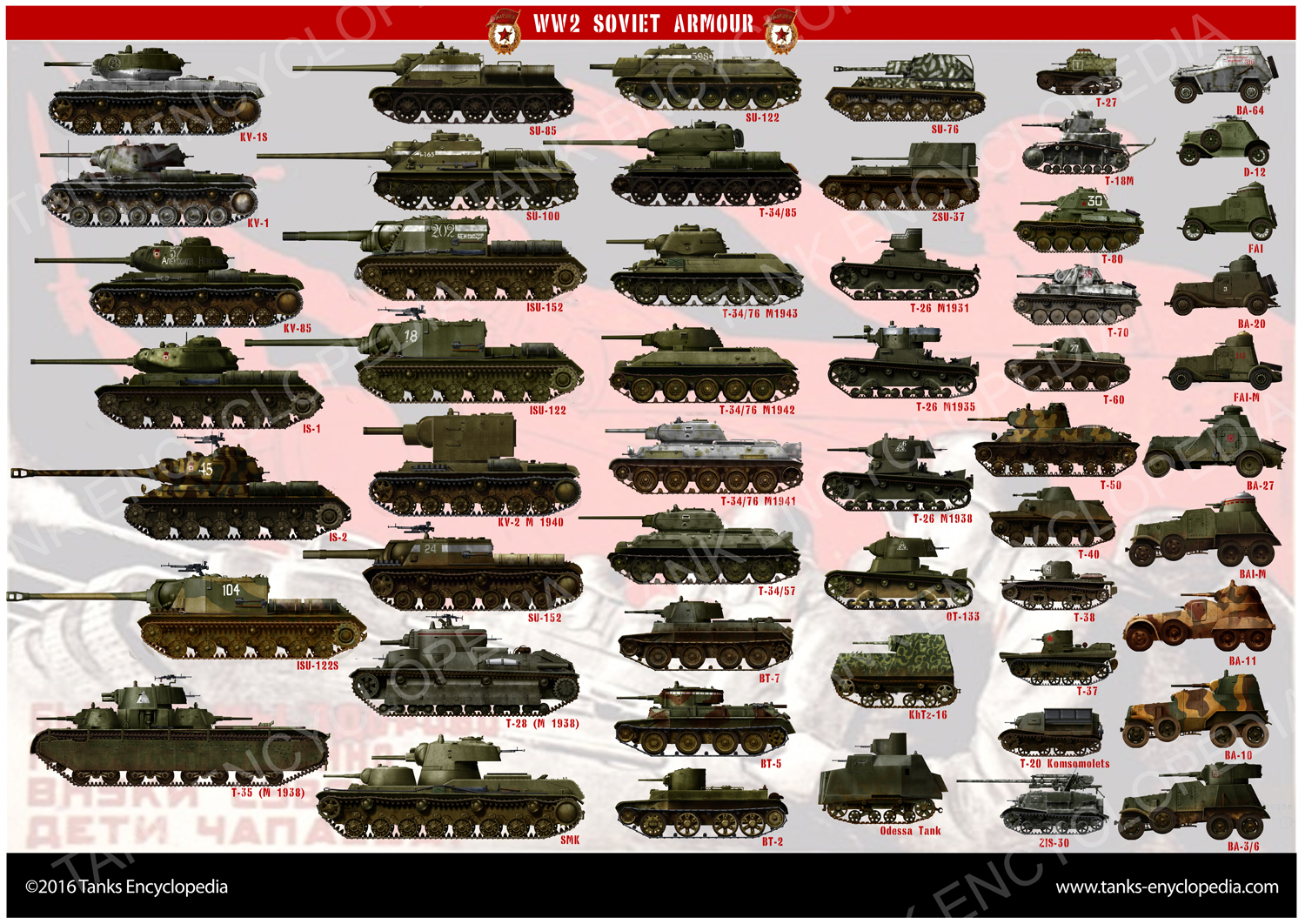
All ww2 Soviet Tanks Posters
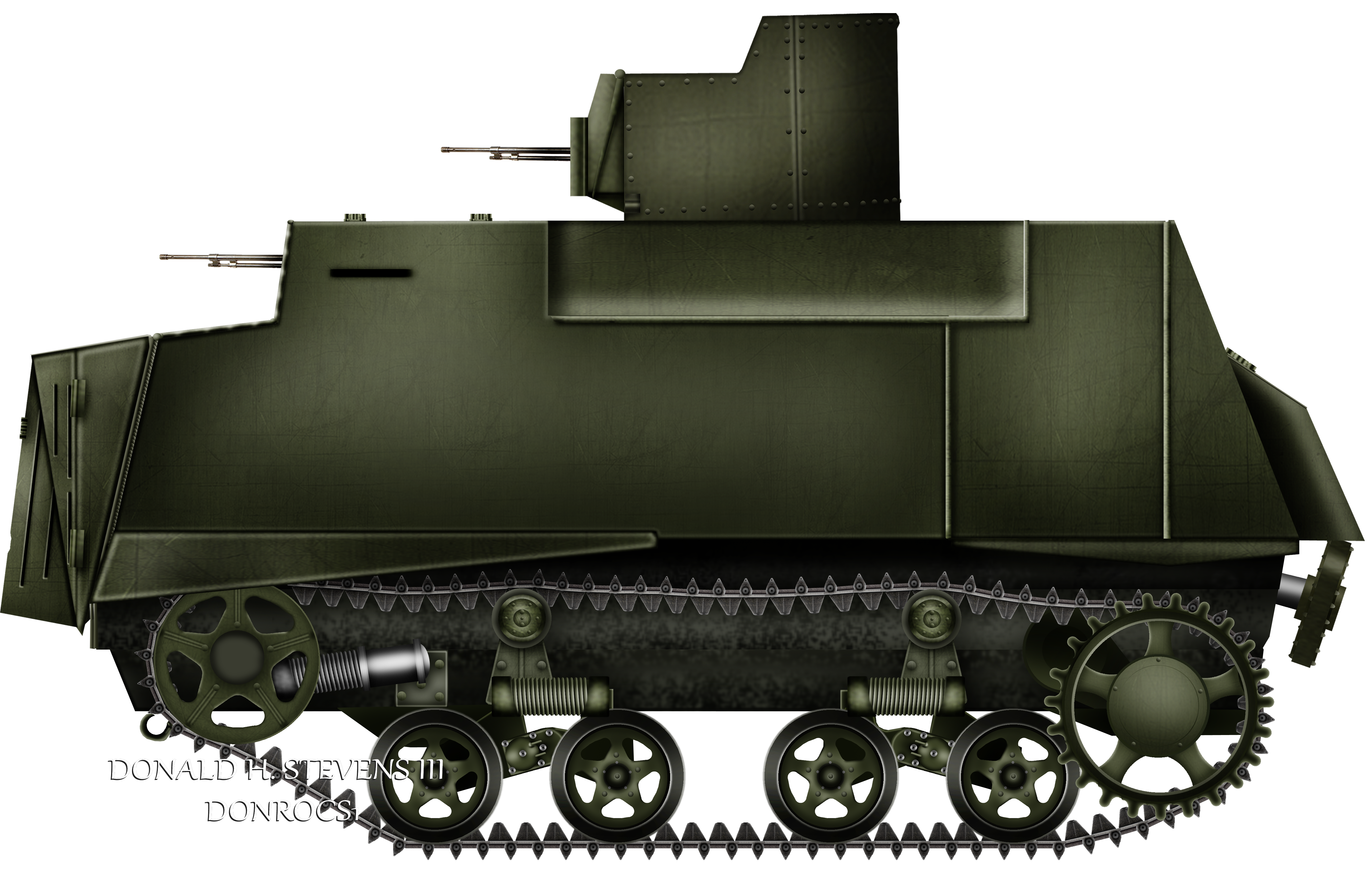
Rendition of a NI improvised tank with a T-26 Model 1931 turret – Illustrator: Donald Stevens
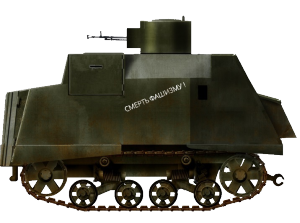
Rendition of a NI improvised tank with a DShK, only one photo shows a NI with what is believed to be a round improvised turret. It is also speculated that an improvised turret would be needed to fit a DShK. Slogan: “Death to Fascism”. In reality, slogans were probably never painted on Odessa Tanks, but in Vladimir Strelkov’s 1986 film “Feat of Odessa, the second series”, a worker wrote this slogan on in chalk – an event sometimes presented as reality by some sources.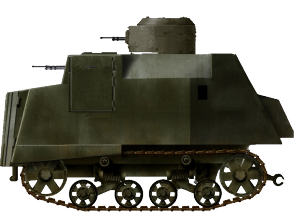
Rendition of a NI with a T-38/T-37A turret. There is a piece of footage that shows this type, except the location of its side viewport is moved higher and closer to the front of the turret, which has never been seen on other examples of T-37A/T-38s. It is most plausible that the turret that has had a repair, forcing the viewport to be moved. It is also highly likely that this is, in fact, an improvised turret.
All known footage of the NI tank, as taken from documentaries, films, and newsreels.
Gallery

Workers present a NI tank with what appears to be some kind of long DT, believed to be a DT-29 with a flash hider. The turret is taken from a T-26 Model 1931 and reportedly would have had a 37mm PS-1 gun; it appears as though it has been removed and replaced with a DT. This was likely done because of a lack of sufficient ammunition. The top hatch is also open in this photo. Senior Lieutenant N. Yudin (sometimes called Artillery Lieutenant) has been speculated to be the man second from the right.
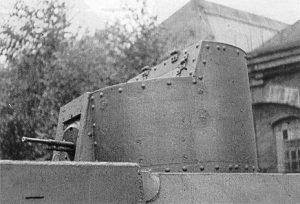
Different view of the above. The top hatch is closed in this photo. Mysteriously, the DT appears to be shorter in this photo, when compared to the above. There remains no explanation for this.
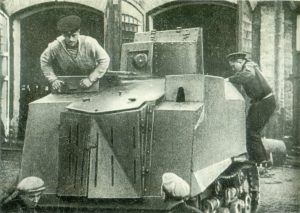
Another view of the above – all three photos are believed to be on August 20th, 1941. It is unclear whether this photo has been altered for clarity of the image.
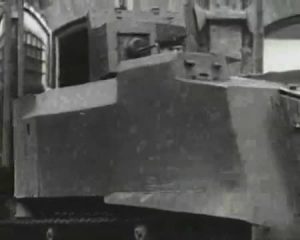
Sideview of the above. This image is taken from a screenshot from footage. Whilst sections of this footage are available in this article, footage of this side of the tank is not.
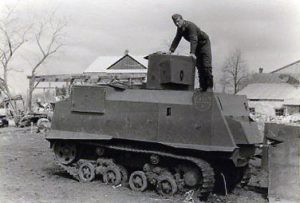
A photograph of a NI with an unknown turret, almost certainly an improvised turret – this turret appears totally cylindrical and is facing 7 o’clock in this photograph. A Romanian soldier stands on top. Notice how it also features an almost square-like emergency hatch and a set of rear mudguards. The toolbox is also clear on the right-hand side of the vehicle. The divisional marking is unknown.
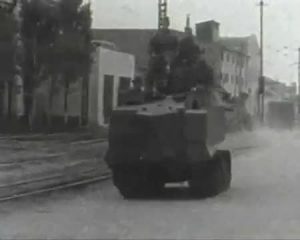
Unknown Odessa Tank, unknown date, unknown location. This vehicle is likely one of the three first production vehicles on its way through Odessa to the Southern Sector to fight at Dalnik under Senior Lieutenant Yudin. Screenshot from untraceable footage.
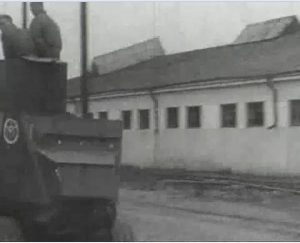
Different view of the above. The turret appears to be a T-26 M1931 turret. There appears to something above the toolbox, possibly a crowbar, but possibly another escape hatch. The divisional marking is unknown. Screenshot from untraceable footage.
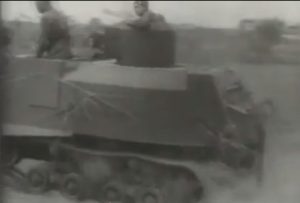
A still from Roman Karmen’s 1965 film “Great Patriotic War” (approximately 25 minutes in) showing a NI tank with what might be an improvised turret similar to a T-37A/T-38 turret. Close examination shows that the viewport is in a very unorthodox location for it to be a T-37A/T-38 turret – however, it may have just been repaired, thus moving the viewport forward. It is also quite likely to be an improvised turret.
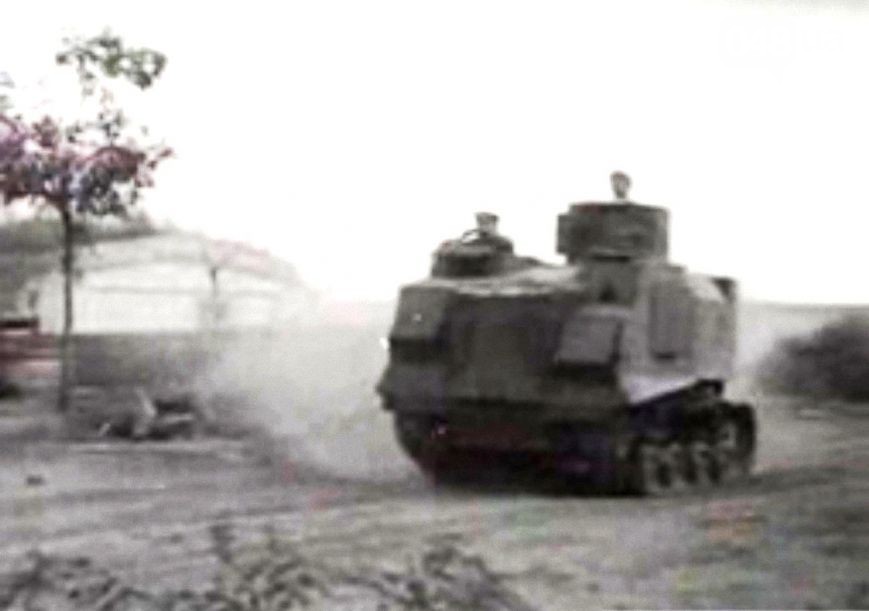
A very grainy photo of a NI. It is unclear where this photo is taken, but it appears to be original. This one appears to feature some additional plates below both sides of the crew compartments at the front of the hull. These may be additional armor plates or additional escape hatches, but it remains a mystery. The engine access hatch also appears flatter than other examples, but, due to the quality of the photo, this, too, is unclear. The turret it features is very unclear, but according to shading, it seems to be an improvised turret. Three crew members can be seen, the commander and driver are easy to spot, but the third crew member of on the right of the gun, just a little to the below-right of the commander.
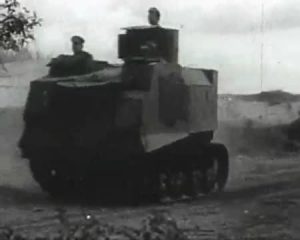
Different view of the above, albeit in higher quality. Screenshot from untraceable footage.
 At least two Odessa Tanks can be seen in this photo near the entrance to the port of Odessa. According to the below photo (judging by the amount of snow), this was taken any time between November 1941 and January 1942. The one on the left has an improvised turret, and one without a turret is just behind it. This equipment was probably left behind after the Soviet withdrawal. The hatch on the turreted Odessa Tank appears to be tall, as in the above photo. Credits: Will Kerrs, private collection.
At least two Odessa Tanks can be seen in this photo near the entrance to the port of Odessa. According to the below photo (judging by the amount of snow), this was taken any time between November 1941 and January 1942. The one on the left has an improvised turret, and one without a turret is just behind it. This equipment was probably left behind after the Soviet withdrawal. The hatch on the turreted Odessa Tank appears to be tall, as in the above photo. Credits: Will Kerrs, private collection.

This is a different view of the above, taken in February, 1942 (according to writing on the reverse of the photo). The shot is taken from the other side. It reveals that one Odessa Tank has no turret turret, and that the other probably had a simple cylinder for a turret. The ZiS truck is visible in the left of the shot, and can be seen in the above. Because they are so close to the port, it is probable that they were used to police the evacuation of the city and were abandoned after. Credit: Frankie Pulham, Private Collection.
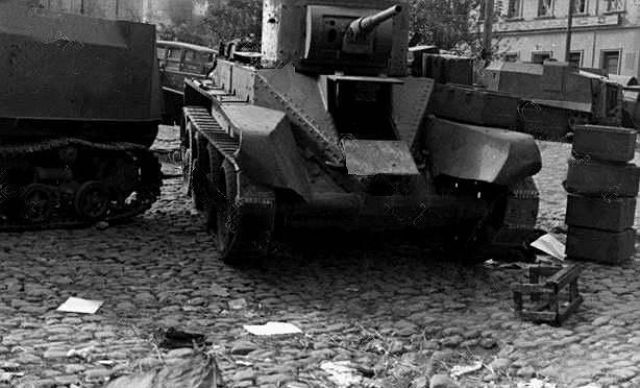
On the left, we can see the rear of a NI. In the background right, we see a NI without a turret. It is possible that there were no turrets left to scavenge or that no turrets could be made, and this one had to make do with just the hull DT. This is believed to be taken after the defense of Odessa was over. It is very possible that the two tanks in shot are the same as the above photos, and that the traffic known near the port of Odessa has been shifted by the occupiers, during 1942, however, this is still in debate. Note: This photo appears to have been lightly edited by use of a cloning tool on photoshop software. This photo has also been seen, heavily watermarked by CEGESOMA. It is unclear why CEGESOMA has a photo of the Odessa Tank.
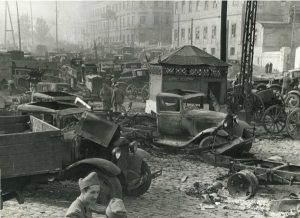
Traffic near the entrance to the port of Odessa. The small ‘pavillion’ hut structure between the closest telegraph pole on the right, and the one just to the left of it. It is probable that the Odessa Tanks were abandoned upon the evacuation of the city.
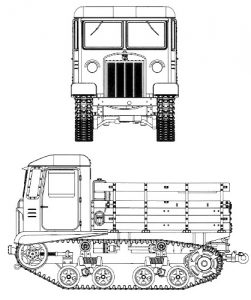
A technical drawing of an STZ-5 tractor.
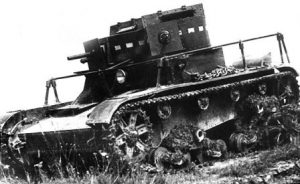
A T-26 ‘Model 1932’ with a 37 mm gun (left turret) and a DT machine gun (right turret). The NI fitted turrets from wrecked T-26 Model 1931 tanks, but there are only photographs of the NI with the DT T-26 Model 1931 turret.
This abandoned factory is believed to be the January Uprising factory. It appears as though it was abandoned decades ago, but was reportedly operational in the 1970s building cranes. Credits: yangur.livejournal.com (More photos)
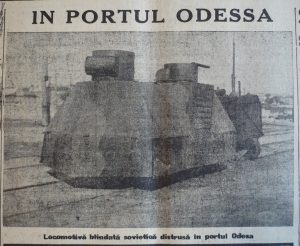
Photograph from a Romanian newspaper of what appears to be an armored tram at Odessa. This idea was likely quickly dismissed in favor of Odessa Tank production. The turrets are improvised and probably similar to those that Odessa Tanks would be fitted with.
Reproductions and Misidentified NIs
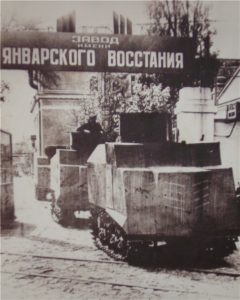
Some slightly odd-looking NI tanks leave the gates of the Odessa factory called “January Uprising”. Despite apparent authenticity, this is actually a photo from a scene from Vadim Lysenko’s 1971 film “The train to the distant August” (“Поезд в далекий август”). These tanks were specially made for this film and were probably scrapped afterwards.
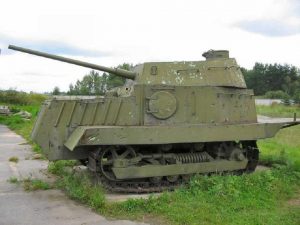
Another supposed reproduction KhTZ-16 or NI tank in a museum in Odessa. This tank is the most common vehicle cited as the NI across internet-based sources. The historical accuracy of this tank is extremely dubious. The construction of this vehicle does not resemble that of a KhTZ-16 or a NI – especially with regards to the turret, main gun, and the suspension of the vehicle. Despite being presented as a KhTZ-16 or a NI, this was a postwar creation based on a postwar tractor as a replica, and looks nothing like any of the WWII improvised tanks.
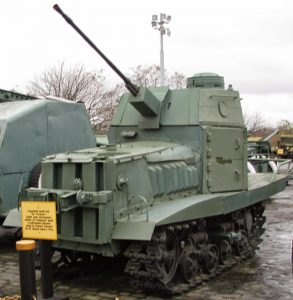
Despite looking more like a KhTZ-16, this tank is actually labelled as a NI. The historical accuracy of this tank is dubious. There is no credible information or historical photographs suggesting that it was armed with this ShVAK weapon, although the KhTZ-16 prototype did feature one. Also, the construction and shape of this tank is dubious, although, it does appear to be based on an STZ-5 tractor. All mentions of a ShVAK being fitted to a NI may have come from this replica.
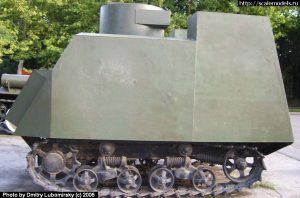
This tank is often presented as a NI tank, but it is a reproduction. This replica is facing right. The historical accuracy of this tank is dubious. It does appear to be based on an STZ-5 tractor, but the shape of this tank could be mistaken for a KhTZ-16. Despite being presented as a NI, there is no credible information or historical photographs suggesting that this armor shape was that of an original NI. The turret, however, is likely somewhat accurate. Its gun was also probably stolen for scrap by criminals. Copyright Dmitry Lubomirsky, 2006.
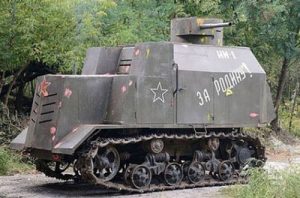
A fairly (but still far from) accurate replica NI tank in Prokhorovka Park, Odessa. It shows an improvised turret (likely quite accurate) with a supposed 45 mm (1.77 in) gun. This is not proof that the NI ever mounted this gun. This vehicle has been vandalized with paint in May, 2015, as seen in the photograph.
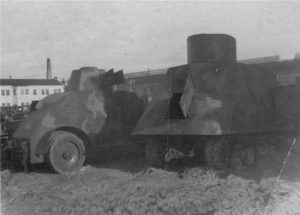
A rear view of what appears to be an Odessa Tank. This can categorically be dismissed as being an Odessa Tank as the hull is totally the wrong shape. Other sources report two rumors of what this vehicle is – the ‘Izhora Bronetraktor’ at Leningrad, or a vehicle built on Saaremaa Island, Estonian SSR. Whilst it remains unclear if these rumors are true, it is fairly evident that the tractor tank in the photo is most probably a policing vehicle made by the Soviet Navy at Tallinn, Estonian SSR, for the unrest of June, 1941. See Soviet Navy Improvised ADG article.
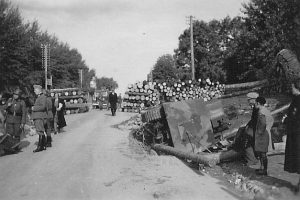
Seemingly another strange type of Odessa Tank, as in the above photograph. As mentioned, this is more than likely a Soviet Navy policing vehicle in Tallinn. It appears to have toppled over into a ditch and is being inspected by Germans and locals. The turret is facing the rear, and it is possible that it was trying to flee before it fell over.

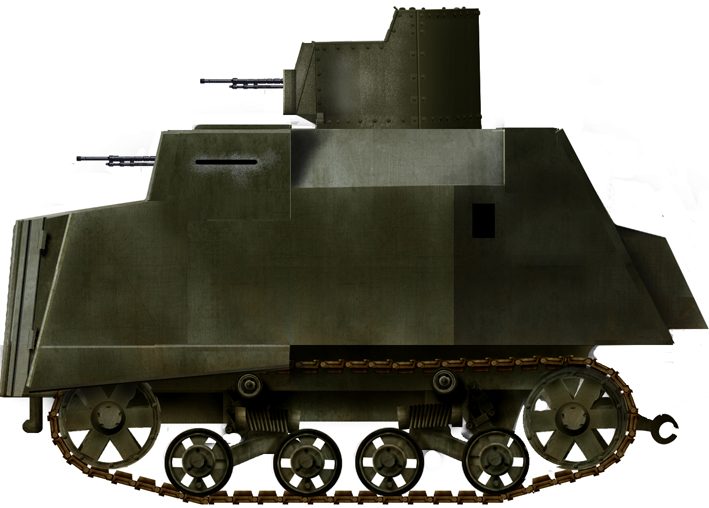
9 replies on “Odessa Tank / NI”
Great collection of information on a rather obscure vehicle. Thank you.
“The NI tank supposedly also made an appearance on Roman Karmen’s 1965 film “Great Patriotic War”, but this is not confirmed, and may be a mistake made by a source.”
Yes, it did, about 25 minutes into it, when they talk about defending Odessa, but you already have the same footage elsewhere (it’s the short clip of the fast-driving not-T-37-turreted tank). No new information.
Thanks for the heads up – the video clip was not labelled properly with that where we found it, so that really clears that up.
Do you happen to know somewhere the entire film can be viewed?
It’s actually kind of confusing. Roman Karmen is a Soviet war cameraman who directed many documentaries, among them “The Great Patriotic War / Великая Отечественная” (1965, 140 min), and “The Great Patriotic War / Великая Отечественная” (1978, series, 17 hours), sometimes known as “The Unknown War” and available in both English and Russian. Karmen used some of the same wartime footage in both films.
The footage I’ve seen is in the 1965 film, which is difficult to find online in entirety. Here is one version (though incomplete, only the first half:
http://kivvi.kz/watch/o6a0vtweg82p/
The tank appears at 24:54. I will not be surprised if the same footage appears in the 1978 series. The link to the 1965 video you posted is blocked in my country (US), so I can’t tell which version it was. Nevertheless, and more importantly, I believe you now have every known footage of this vehicle combined in one handy video.
Once again, thank you for this very comprehensive site.
Check your mail Tankman.
Thank you, Dr. Tankman. I really appreciate the clarifications there. The article has had a bit of a rework. General editing here and there, some clarifications, and, of course, a new compilation video with more footage. (Yep, I know I wrote “Odessa Film Studios” twice in a row a few times. Oops.)
It does, indeed, seem that there are two versions of Karmen’s Great Patriotic War – in the video compilation of the Odessa Tank you can hear a different voice-over to the one from the whole movie that i’ve linked (that you can’t access, unfortunately). I was wondering about that, but this explains it.
I also managed to find footage of replica Odessa Tanks in “Feat of Odessa, the second series”, 1986. I never knew about it, but I really enjoy the tone of the film and their re-enactment of the presentation of the Odessa Tank. An interesting parallel between cinema and reality that i’ve mentioned in the new “Cultural Significance” paragraph. It also explains a lot of sources’ claims of “Death to Fascism” and other slogans/names being written on tanks.
As for being comprehensive – this particular tank has been a big project of mine for about a year. With over 200 revisions, i’ve really tried hard to nail this thing, and, I think I have.
communist bob semple
LOL
> Reportedly, “военинжинер” Obednikov (there appears to be no translation of his title)
This is a shortened form of “военный инженер” (military engineer) and has several grades (for example, “военинженер 3 ранга” (military engineer 3rd rank) would be equivalent in rank to an army Captain. 2nd and 1st rank are equivalent respectively to Major and Colonel. While those are actual ranks, they were abolished in 1940, so usage of them is indeed quite confusing.